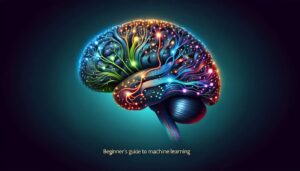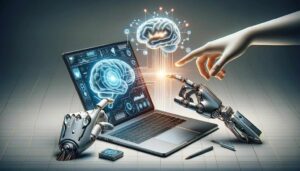Beginner’s Guide to Machine Learning: Unraveling the Magic of Algorithms
Welcome to the enchanting world of Machine Learning (ML)! Whether you’re a curious student or an aspiring tech enthusiast, this guide is your gateway to understanding the basics of ML and embarking on an exciting journey into the realm of artificial intelligence (AI).
At its core, Machine Learning is about teaching computers to learn from data, make decisions, and predict outcomes without being explicitly programmed for each task. It’s a branch of artificial intelligence that focuses on building systems capable of automatically learning and improving from experience.
What is Machine Learning?
Machine learning is a fascinating subset of AI that empowers computers to learn from data and improve their decision-making over time. Unlike traditional programming, where rules are explicitly coded, ML involves algorithms that enable computers to recognize patterns and make decisions with minimal human intervention. Think of ML as teaching a child to differentiate between cats and trucks by showing them numerous pictures; similarly, ML algorithms learn by processing vast amounts of data.
Key Concepts in Machine Learning
1. Types of ML Models:
Supervised Learning: This is like having a teacher guide the learning process. The algorithm learns from labelled data, making it easier to predict outcomes based on past examples.
The model learns to make predictions based on the input-output pairs in the training data. Examples include classification tasks, like spam detection, and regression tasks, like predicting house prices.
Unsupervised Learning: Here, the algorithm explores data on its own, identifying hidden structures within unlabeled data.
In this type, the model deals with unlabeled data. It tries to find patterns and relationships in the data on its own. Common applications include clustering (like customer segmentation) and association (like market basket analysis).
Reinforcement Learning: This type involves algorithms learning to make decisions by trial and error, much like learning to play a video game.
Here, an agent learns to make decisions by performing actions in an environment to achieve some goals. The agent learns from the outcomes of its actions, rather than from being told explicitly whether it is right or wrong. This type is often used in gaming, navigation, and real-time decisions.
2. Applications of ML:
From powering self-driving cars to optimizing healthcare treatments, ML’s versatility is endless. It’s used in areas like robotics, autonomous vehicles, recommendation systems, and more.
Machine Learning (ML) has revolutionized countless fields and industries, offering innovative solutions and enhancing efficiencies in ways previously unimaginable. Let’s explore some of these applications in detail, illustrating how ML is not just a buzzword, but a transformative technology.
a. Healthcare
Disease Diagnosis: ML algorithms can analyze complex medical data and images, aiding in early and accurate diagnosis of diseases like cancer. For example, AI-driven tools are now capable of detecting skin cancer by analyzing images of skin lesions with accuracy comparable to dermatologists.
Drug Discovery: Machine learning speeds up the process of drug development, analyzing molecular and clinical data to find potential drug candidates. This was notably seen in the rapid development of COVID-19 vaccines and treatments.
b. Finance
Fraud Detection: ML algorithms excel in identifying unusual patterns indicative of fraudulent activities. Banks and financial institutions use ML to monitor transactions in real-time, flagging anomalies that suggest fraudulent behaviour.
Algorithmic Trading: ML models analyze vast amounts of financial data to identify trading opportunities, predict stock trends and execute trades at high speeds.
c. Retail and E-Commerce
Personalized Recommendations: Online retailers like Amazon use ML to analyze browsing and purchasing patterns, offering personalized product recommendations to enhance user experience and boost sales.
Inventory Management: Machine learning aids in predicting inventory demand, optimizing stock levels, and reducing waste, especially in sectors like fashion and perishable goods.
d. Autonomous Vehicles
Self-Driving Cars: Companies like Tesla and Waymo are pioneering the use of ML in developing autonomous vehicles. These cars use ML to interpret sensor data, allowing them to navigate roads, recognize obstacles, and make safe driving decisions.
e. Entertainment and Media
Content Recommendation: Streaming services like Netflix and Spotify use ML algorithms to recommend movies, shows, and music based on individual user preferences, enhancing user engagement.
Game Development: Video game developers use ML to create more realistic and engaging gaming experiences, with non-player characters (NPCs) that can adapt and respond to player actions in more human-like ways.
f. Smart Devices and IoT
Voice Assistants: Devices like Amazon Echo and Google Home use ML for natural language processing, enabling them to understand and respond to voice commands.
Smart Home Devices: Thermostats like Nest learn user preferences and optimize home heating and cooling for comfort and energy efficiency.
g. Agriculture
Crop and Soil Monitoring: ML algorithms help in analyzing soil data, weather patterns, and satellite images to provide insights into crop health, soil quality, and optimal planting strategies.
h. Education
Personalized Learning: ML enables the development of adaptive learning systems, which tailor educational content to the individual learning pace and style of each student.
i. Environmental Protection
Climate Change Analysis: ML models analyze environmental data to track climate change patterns, helping in predictive modelling and formulating strategies to mitigate adverse effects.
j. Customer Service
Chatbots and Virtual Assistants: Many businesses employ ML-driven chatbots for customer service, capable of handling inquiries and providing information 24/7 without human intervention.
In each of these fields, the common theme is the ability of machine learning to process large volumes of data, recognize patterns, and make predictions or decisions. This capability is leading to more personalized, efficient, and effective services across various sectors, fundamentally changing the way we interact with technology and making what was once science fiction a reality.
3. Crucial Elements in Machine Learning
Algorithms: These are the rules or methods the model follows to learn from data and make predictions. Algorithms vary greatly depending on the type and complexity of the task at hand.
Data: The quality and quantity of data are crucial. Machine learning models learn and improve based on the data they are trained on. The data needs to be cleaned, processed, and sometimes augmented for effective learning.
Features: In ML, features are individual measurable properties or characteristics of the phenomena being observed. Good feature selection can significantly improve the performance of a model.
Model Training and Testing: Training involves feeding the model data and allowing it to learn and make predictions. Testing the model on new data helps evaluate its performance and accuracy.
Hyperparameter Tuning: This is the process of adjusting the model parameters to optimize its performance. It’s a crucial step to ensure the model works well on different kinds of data.
4. Machine Learning vs. Traditional Programming:
Traditional programming relies on explicit instructions for specific tasks, while ML algorithms learn from data, adapting and improving over time. This adaptability makes ML ideal for dynamic and evolving scenarios.
How Does Machine Learning Work?
The ML process involves several steps, from data collection to model deployment. It begins with gathering and preparing data, selecting the right model, training the model, and then evaluating and deploying it. This iterative process ensures that the model performs well on new, unseen data.
5. The Journey to Mastering ML
1. Understand the Foundations:
Grasping the basics of linear algebra, calculus, and optimization is crucial. These mathematical concepts form the backbone of ML algorithms.
2. Learning by Doing:
Experiment with simple ML projects. Start with basic algorithms and gradually move to more complex projects. The key is to learn by applying.
3. Dive Deeper:
As you grow more comfortable with the basics, explore advanced topics like deep learning, neural networks, and reinforcement learning.
6. Challenges and Limitations
While ML is powerful, it’s not without its challenges. These include the need for large data sets, potential safety concerns (especially in critical applications), and the complexity of designing effective reward systems in reinforcement learning models.
Machine Learning (ML) has indeed been a game-changer in many fields, but it’s not without its challenges and limitations. These issues can range from technical and practical aspects to ethical concerns. Let’s explore these hurdles in a straightforward and relatable manner.
Data Quality and Quantity
Dependency on Data: ML algorithms learn from data. If the data is flawed (biased, incomplete, or inaccurate), the model’s predictions and decisions will be too. For example, if a facial recognition system is trained mostly on images of people from a particular demographic, it may not perform well with faces from other demographics.
Need for Large Data Sets: Many ML algorithms, especially deep learning, require vast amounts of data for training. This can be a significant limitation in fields where data is scarce or expensive to acquire.
Model Complexity and Interpretability
Complexity: Some ML models, particularly deep learning networks, are incredibly complex and behave like “black boxes”. This means it’s difficult to understand how they arrived at a particular decision or prediction. For instance, in critical applications like healthcare or criminal justice, not knowing why a machine made a certain decision can be a significant issue.
Overfitting: This happens when a model is too complex and learns to fit the training data too closely, including its noise and errors, and performs poorly on new, unseen data.
Ethical and Societal Issues
Bias: ML models can inadvertently become biased, reflecting any biases present in the training data. An example is gender or racial bias in hiring tools, where the system might prefer candidates similar to those it has seen in the training data, which could be skewed towards a particular gender or race.
Privacy Concerns: ML often requires personal or sensitive data. Ensuring this data is used ethically and protecting individuals’ privacy is a significant concern.
Practical and Operational Challenges
Resource Intensive: Training sophisticated ML models require significant computational resources, which can be costly and environmentally taxing.
Real-World Application: Translating a model that works well in a controlled or laboratory setting to a real-world scenario can be challenging. Models might struggle with the variability and unpredictability of real-world data.
Safety and Reliability
Safety in Critical Applications: In areas like autonomous vehicles or medical diagnosis, the stakes for ML systems are incredibly high. Ensuring these systems are reliable and safe under all conditions is a major challenge.
Adversarial Attacks: ML systems can be susceptible to adversarial attacks, where slight, often imperceptible, alterations to input data can lead to incorrect outputs. For example, subtle alterations to stop signs can cause an autonomous vehicle to misidentify them.
Updating and Maintenance
Continual Learning and Adaptation: ML models may not adapt well to changes over time unless they are specifically designed for this. They often require retraining or updating, which can be resource-intensive.
Legal and Regulatory Challenges
Regulation and Compliance: As the use of ML expands, so do concerns about regulatory compliance. Different countries and regions have varying laws regarding data use, privacy, and AI, making it complex for global operations.
In summary, while ML has immense potential, navigating these challenges is crucial for its responsible and effective use. Addressing these issues requires a combination of technical innovation, ethical considerations, and often, regulatory frameworks. The goal is to leverage the power of ML while minimizing its risks and ensuring its benefits are equitably distributed.
7. The Future of Machine Learning
Machine Learning is not just a fleeting tech trend; it’s a transformative technology shaping our future. From enhancing business operations to revolutionizing medical diagnostics, ML’s potential is boundless. As you embark on this journey, remember that learning ML is a marathon, not a sprint. With patience, practice, and a spirit of exploration, you’ll be well on your way to mastering the art of algorithms and contributing to this exciting field.
Embrace the journey into ML with an open mind and a thirst for knowledge. The road ahead is filled with learning opportunities and the potential to make a significant impact in the world of technology. Happy learning!







